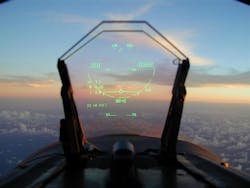Display debate: Engineers and executives look to solve challenge of pilot workload, need for enhanced situational awareness
MUNICH, 21 Feb. 2013. Engineers, product managers, and project managers at Avionics Europe 2013 in Munich debated and discussed advanced cockpit display technologies, including bleeding-edge solutions devised to deliver increased situational awareness and reduce pilot workload and fatigue.
The panel of avionics professionals included:
Okko Bleeker, Rockwell Collins, involved with displays and human factors
Vance Hilderman, Atego HighRely
Gang He, Honeywell Aerospace
Nathaniel (Nate) Kowash, Rockwell Collins, HUD team
Mike Tolfree, ENSCO Avionics/IData Visual Systems Group
Kristof Vierin, Barco
Dan Joncas, CoreAVI
An aircraft operator is perhaps most concerned with capabilities, functionality, and design of the display (data delivery system) of all the avionics in the cockpit, whether on new platforms or retrofitted and upgraded aircraft. Pilots are reliant upon effective display avionics, particularly in low-visibility and high-traffic environments. Cutting-edge technologies exist both to increase the pilot’s situational awareness (view of the surroundings) and to reduce pilot workload and fatigue.
Consumer electronics firms endeavor to enter the aircraft display market and deliver high-resolution, innovative displays to the aviation community. Many are targeting military flight trainer and general aviation display applications.
Other cockpit display activities in which Atego is involved include:
Applying Java solutions to displays via Aonix Perc
Applying DO-297 IMA for cockpit/display solutions
Hilderman has noticed the following trends and predictions:
1. Advanced consumer display technology built into cockpit displays
2. Simulated 3D, solves depth perception issues
3. Touch screens – consumer-based and higher-resolution
4. DO-297 integrated solutions for the cockpit
5. Greater user customization
6. FACE (Future Airborne Capability Environment) in the cockpit
Challenges related to cockpit displays include:
- FAA and EASA
- The fact that they are ultra critical brings reluctance to adopt unproven technologies
- Rotorcraft rough environment (vibration and exposure)
- Pilot acceptance – Can old dogs learn new tricks?
